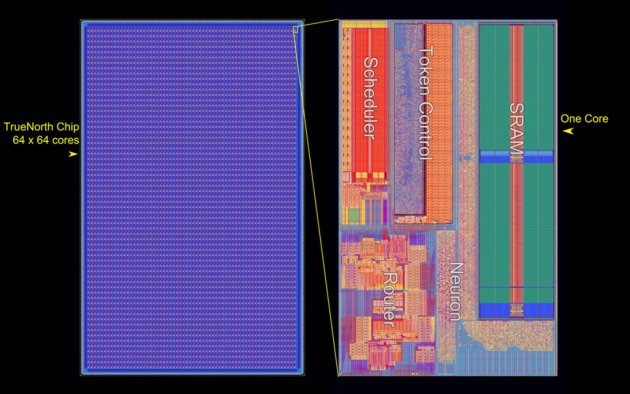US Air Force uses IBM's neuromorphic chip to detect tanks and ground air defense systems

Modern technology is very interested in the military. It is no secret that many technologies were first created for military needs, and then they appeared in the ordinary life of civilians. Now the US Air Force is testing in field conditions a neuromorphic chip created by IBM specialists. This chip has already been published in the blog of our company. It can be used for a variety of purposes, and one of them is the detection and identification of certain objects.
The United States Air Force, namely the Air Force Research Lab (AFRL), uses the capabilities of the processor to identify military and civilian vehicles during airborne radar. The military claim that the chip works no worse than a powerful military computer. But the energy consumed is twenty times less.
In 2014, IBM signed a contract with the military worth about $ 550,000. It was the United States Air Force that became the first organization to sign an agreement with IBM for the supply and testing of such a chip. This is a processor TrueNorth. TrueNorth consumes much less energy and takes up less space than traditional computer systems. Thus, a separate TrueNorth chip, containing 5.4 billion transistors, consumes only 70 mW of power. And an Intel processor with 1.4 billion transistors consumes 35 to 140 watts.
')

TrueNorth chips have significant advantages over GPU and FPGA. IBM is hoping that TrueNorth will be the factor that will allow computer systems to enter a new stage of development. New technologies can be used not only to create smartphones or smart watches - neuromorphic chips can be used in high-performance systems installed in data centers.
TrueNorth chip is made on 28 nm process technology. It contains 5.4 billion transistors and is a neuromorphic system with the following characteristics:
• one million emulated "neurons"
• 256 million emulated connections between neurons - “synapses”
• about 400 megabytes of SRAM memory (approximately 50 megabytes)
The processor includes 4096 blocks located in a two-dimensional array of 64 * 64. Each block includes a scheduler, a token control module, a memory, a communication module with adjacent blocks, and a logical system of “neurons”. Asynchronous chip making technology. According to experts, the performance of systems based on the chip is 46 billion "synaptic operations per second per watt."
The military has assembled a chip-based prototype of a computer vision system, which in the ordinary case requires very powerful equipment and quite a lot of space. But there is not much space in the satellites or high-altitude vehicles; therefore, it is simply impossible to place a traditional system of this type with a traditional structure there. But a similar system, only assembled on neuromorphic chips, is quite possible to assemble. "The main areas of interest for the Air Force are airspace, outer space, and cyberspace," says AFRL chief executive Qing Wu. It is here that it is planned to test the full capabilities of neuromorphic chips from IBM.

Wu says his lab conducted benchmarking tests between TrueNorth and JetsonTX-1, Nvidia's high-performance computer adapted for machine learning. Both systems use a different implementation of image processing using the capabilities of neural networks. The military conducted comparative tests to determine the types of ground transportation, including T-72 tanks, armored vehicles and bulldozers. As it turned out, both TrueNorth and JetsonTX-1 were able to identify all detected modes of transport with an accuracy of 95%. But the system based on TrueNorth at the same time used 20-30 times less energy than JetsonTX-1. For the military, this is critical, so the preference for further work is likely to be given precisely to the neuromorphic chips.
Also, Air Force Research Laboratory uses a chip in autonomous drones when flying long distances, when the system is not controlled by a human. “At the same time, the drone understands where it is, what to do and where to fly,” says King Wu, head of the Air Force Research Laboratory, “We need powerful, energy-efficient processors. And IBM TrueNorth is exactly what is required. ”
Based on TrueNorth , Samsung has created a machine vision system. The principle of operation of the entire system is different from the principle of operation of ordinary cameras, which made it possible to increase the processing speed of the video stream to 2 thousand frames per second. In the most advanced cameras, this indicator does not exceed 120 fps (with the exception of a number of specialized cameras). The new system can be used in many areas, including gesture recognition. Samsung's “digital eye” can pick up small movements over considerable distances (5-6 meters or more). The power consumption of the “digital eye” is minimal and is about 300 mW. "This is a hundred times less than the average performance of a laptop processor and ten times less than the power consumption of a processor installed in conventional smartphones," said Eric Ryu, vice president of Samsung Advanced Institute of Technology.
Now IBM is improving the TrueNorth systems and trying to make their production cheaper, so that new systems are more accessible for a wide range of users.
Source: https://habr.com/ru/post/323722/
All Articles